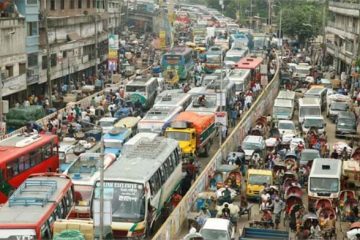 Dhaka City Corporation (DCC) has failed to take any effective measures to prevent random installation of advertising hoardings, mostly illegal, posing serious risk to city dwellers, especially during storm.
Dhaka City Corporation (DCC) has failed to take any effective measures to prevent random installation of advertising hoardings, mostly illegal, posing serious risk to city dwellers, especially during storm.
Only in the last week, three billboards collapsed in different parts of the capital.
On May 6, a young man died and three others sustained injuries when a billboard broke down on a phone shop near the Zia International Airport during storms. However, no one was reported injured in two other incidents–one in front of Siddheswari Girls High School on Bailey Road on May 3 and another at Technical in Mirpur yesterday.
The haphazard setting up of billboards and other advertisement boards are also impairing the beauty of the city, said residents of different areas.
When it came to launching the drive against illegal advertising hoardings the DCC has been conspicuous by its absence over the last eight months, said a DCC official.
The hoardings are not only put up along the roads but also on rooftops of roadside buildings and on both private and government lands, many of them have very poor foundation, said an official of DCC.
He said, as per DCC count in October 2008, the total number of billboards in the city was around 2200. Of which 485 were on roofs of DCC buildings or their lands and 1695 were on roofs and lands of private owners and other government agencies.
The number has increased a lot after that, he added.
At least two people were also killed and several others injured in two separate incidents of billboard collapse in May and June in 2006.
The number of billboards on roofs of private buildings is more than on the lands. The DCC failed to take any steps in pulling down those structures due to legal tangle, he said.
The DCC, as per its decision in July 2007, asked building owners through an advertisement published in a number of national dailies to pull down all hoardings and signs immediately.
Rajuk in a notice on September 9, 2007 published in several national dailies also asked all building owners to remove hoardings from its jurisdiction of 1530 square kilometer by September 16, 2007.
The initiatives of the DCC and Rajuk to pull down hoardings from rooftops had come to a halt following a High Court stay order against the moves, said Maksudur Rahman Chowdhury, chief waste management officer of DCC.
The High Court on September 20, 2007 asked authorities concerned not to pull down hoardings and signs for 14 days which was later extended after a writ petition filed by the Outdoor, an advertisement owners’ association, said the official.
“We cannot take steps in many cases against illegal billboards due to legal complication,” he said.
A committee is likely to be formed shortly, which will take decision about the fate of illegal billboards and other advertisement on the rooftops of private buildings, he said.
“We have also taken initiatives to revise the advertisement guidelines of DCC to make it more effective which might be completed in the next month,” he added.
As per the municipal corporation (taxation) rules 1986, any person intending to erect a billboard or sign (neon sign or plastic sign) on a private land or building or on a municipal land or building for display of advertisement shall be required to obtain prior permission from the DCC on payment of tax required.
But most of the owners of the private land and buildings did not have any prior permission from DCC and even they do not pay any tax, he said.
The DCC has so far allowed about 485 hoardings in the city on its lands and buildings but several thousand billboards were set up illegally mostly on the private lands, said another official of the DCC.
In many cases, the firms put up hoardings more than the permitted number, DCC sources said.
A list of 462 illegal billboards is now pending with the estate department and the drive against them may be launched any time, said another official of DCC.
“We cannot conduct drive continuously due to shortage of manpower,” he added.

















